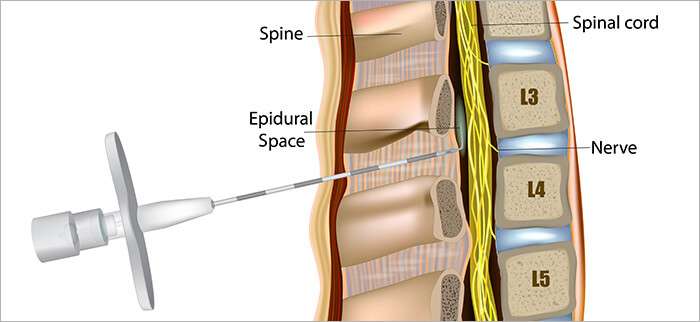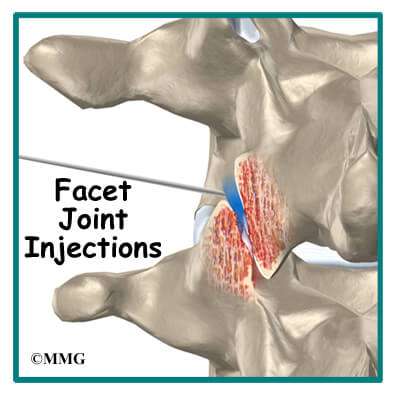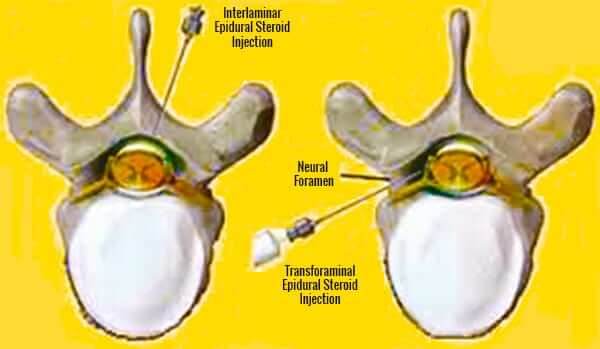
Picture this: You wake up with a nagging pain in your lower back that just won’t go away. After trying different home remedies and over-the-counter medications, you decide to consult a doctor in search of relief. Your doctor suggests an injection for back pain as the next step in treatment.
But what types of back pain injections are available? What do they treat? How effective are they?
In this article, we’ll explore seven types of injections for back pain relief and discuss their potential benefits and risks.
Read: Managing Back Pain Before Period: Tips and Techniques
Here are the 7 types of injections for back pain relief:
1. Epidural Steroid Injections (ESI)

An epidural steroid injection (ESI) is a minimally invasive procedure that involves injecting anti-inflammatory medications, typically corticosteroids, into the epidural space of the spine. The purpose is to reduce inflammation of the nerve roots that may be causing pain in the back or legs.
How it works
ESI injections are administered near the affected nerve root, which is often located at the opening where the nerve exits the spine (also known as the “nerve root sleeve”). The corticosteroid medication reduces inflammation and swelling of the nerve roots, relieving compression and pain.
Benefits
The primary benefit of ESI injections is that they can provide long-term relief from lower back and leg pain, as well as other types of chronic pain associated with the spine. In addition, the anti-inflammatory effects of corticosteroids are known to reduce irritation in nerve roots and improve range of motion.
Risks and side effects
ESI injections are considered a safe procedure with minimal risk but there may be some side effects, such as nerve damage, headache, or temporary localized pain at the injection site. It is important to discuss all potential risks with your doctor prior to having an ESI injection.
2. Facet Joint Injections

Facet joint injections are a type of injection used to treat chronic neck and back pain by reducing inflammation and providing relief from discomfort. Facet joints, also known as zygapophysial joints, are located in the spine and connect each vertebra to its adjacent vertebra.
How it works
Facet joint injections involve the injection of a local anesthetic and/or corticosteroid medication into one or more facet joints in the spine, providing instant relief from pain due to inflammation. The injection numbs the nerve endings around the joint, reducing pain sensations, as well as providing an anti-inflammatory effect to reduce swelling and improve mobility.
Benefits
The primary benefit of facet joint injections is that they can provide almost immediate relief from chronic neck or back pain. Additionally, the anti-inflammatory effects of corticosteroids can help reduce inflammation in surrounding tissues and improve the range of motion.
Risks and side effects
Facet joint injections are considered a safe procedure, but there may be some risks and potential side effects, such as nerve damage, headache, or temporary localized pain at the injection site. It is important to discuss all potential risks with your doctor before having a facet joint injection.
3. Selective Nerve Root Block

A selective nerve root block (SNRB) is a minimally invasive procedure used to diagnose and treat neck, arm, and back pain. This type of injection involves the use of local anesthetics, corticosteroids, or other medications injected directly into the affected nerve root. It can provide relief from chronic pain, as well as reduce inflammation and improve mobility.
How it works
During a SNRB procedure, a doctor will inject the medication of choice directly into the affected nerve root(s). The local anesthetic numbs the area to provide instant relief from pain, while the corticosteroid helps reduce inflammation and swelling in the surrounding tissues.
Benefits
The primary benefit of SNRB injections is that they can provide immediate relief from chronic neck, arm, and back pain. Additionally, the anti-inflammatory effects of corticosteroids can help reduce inflammation in surrounding tissues and improve the range of motion.
Risks and side effects
SNRB injections are considered a safe procedure, but there may be some potential risks and side effects, such as nerve damage, headache, or temporary localized pain at the injection site. It is important to discuss all potential risks with your doctor before having an SNRB injection.
4. Transforaminal Epidural Injections (TFE)

Transforaminal epidural injections (TFE) are a minimally invasive procedure used to diagnose and treat neck, arm, and back pain. This type of injection involves the use of anesthetic or corticosteroid medications injected directly into the epidural space near a spinal nerve root.
How it works
During a TFE injection, the anesthetic numbs the affected nerve to provide instant pain relief, while corticosteroids reduce inflammation and swelling in the surrounding tissues. The medications are injected directly into the epidural space, which is located between the vertebrae and dura mater (the outermost layer of tissue encasing the spine).
Benefits
The primary benefit of TFE injections is that they can provide almost immediate relief from chronic neck, arm, and back pain. Additionally, the anti-inflammatory effects of corticosteroids can help reduce inflammation in surrounding tissues and improve range of motion.
Risks and side effects
TFE injections are considered a safe procedure, but there may be some potential risks and side effects, such as nerve damage, headache, or temporary localized pain at the injection site. It is important to discuss all potential risks with your doctor before having a TFE injection.
5. Sacroiliac Joint Injections

Sacroiliac joint injections are a minimally invasive procedure used to diagnose and treat sacroiliac (SI) joint-related back pain, as well as hip pain due to arthritis or bursitis. This type of injection involves the use of local anesthetic and/or corticosteroid medications injected directly into the SI joints located in the lower back area where the sacrum meets the pelvis on either side.
How it works
During an SI joint injection, a doctor will inject an anesthetic, a corticosteroid, or a combination of the two medications into the SI joint(s). The anesthetic numbs the area to provide instant relief from pain, while the corticosteroid helps reduce inflammation and swelling in surrounding tissues.
Benefits
The primary benefit of SI joint injections is that they can provide almost immediate relief from back pain, as well as hip pain due to arthritis or bursitis. Additionally, the anti-inflammatory effects of corticosteroids can help reduce inflammation in surrounding tissues and improve the range of motion.
Risks and side effects
SI joint injections are considered a safe procedure, but there may be some potential risks and side effects, such as nerve damage, headache, or temporary localized pain at the injection site. It is important to discuss all potential risks with your doctor before having a SI joint injection.
6. Trigger Point Injections

Trigger point injections are a minimally invasive procedure used to diagnose and treat chronic myofascial pain syndrome. This type of injection involves the use of anesthetic or corticosteroid medications injected directly into a “trigger point” or knot in the muscle, which is responsible for causing pain.
How it works
During a trigger point injection, the doctor will inject an anesthetic, corticosteroid, or combination of both medications into the affected area. The anesthetic numbs the affected area to provide instant relief from pain, while corticosteroids help reduce inflammation and swelling in surrounding tissues.
Benefits
The primary benefit of trigger point injections is that they can provide almost immediate relief from chronic myofascial pain syndrome. Additionally, corticosteroids help reduce inflammation in surrounding tissues and improve the range of motion.
Risks and side effects
Trigger point injections are considered a safe procedure, but there may be some potential risks and side effects, such as nerve damage, headache, or temporary localized pain at the injection site. It is important to discuss all potential risks with your doctor before having a trigger point injection.
7. Intradiscal Electrothermal Therapy (IDET)

Intradiscal electrothermal therapy (IDET) is an advanced, minimally invasive procedure used to treat chronic low back pain that is caused by disc degeneration or injury. During the procedure, heat energy is delivered to the inner wall of the spinal disc using a specially designed catheter in order to reduce pain and improve function.
How it works
During the IDET procedure, a doctor will insert a small catheter into the affected disc and deliver heat energy to the inner wall of the disc. The heat energy helps reduce inflammation in surrounding tissues, which can provide relief from pain as well as improve range of motion.
Benefits
The primary benefit of IDET is that it can provide long-term relief from chronic low back pain caused by disc degeneration or injury. Additionally, the anti-inflammatory effects of heat energy can help reduce inflammation in surrounding tissues and improve the range of motion.
Risks and side effects
IDET is considered safe, but there may be some potential risks and side effects, such as nerve damage or infection. It is important to discuss all potential risks with your doctor before having an IDET procedure.
What If These Types of Injections for Back Pain Don’t Work?
If these types of injections for back pain do not provide relief from your symptoms, there are a variety of other options available. These include physical therapy, medications, bracing and supports, heat/cold therapy, and more. Your doctor will be able to evaluate your specific situation and help determine the best treatment option for you.
Read Also: Are Back Pain Injections Safe? Let’s find out
Final Takeaway
Overall, many types of injections can be used to alleviate back pain. However, it is important to speak with a doctor about the best options for treating your particular condition and understanding any potential risks involved with specific injection treatments. Types of injections for back pain include epidural steroid injections (ESI), facet joint injections, selective nerve root blocks, transforaminal epidural injections (TFE), sacroiliac joint injections, trigger point injections, and intradiscal electrothermal therapy (IDET). Each type of injection offers its own unique benefits in terms of providing relief from chronic pain and improving the range of motion. However, it is important to discuss all potential risks with your doctor before having any type of injection for back pain.
Read: Is Upper Back Pain a Sign of Labor?
FAQ
What kind of injections are given for back pain?
Types of injections for back pain include epidural steroid injections (ESI), facet joint injections, selective nerve root blocks, transforaminal epidural injections (TFE), sacroiliac joint injections, trigger point injections, and intradiscal electrothermal therapy (IDET).
What is the best injection for nerve pain?
The best injection for nerve pain is typically a selective nerve root block. This type of injection helps reduce inflammation in the affected area and provides relief from the pain associated with damaged or compressed nerves.
What are the types of injections for lower back pain?
Types of injections for lower back pain include epidural steroid injections (ESI), facet joint injections, selective nerve root blocks, transforaminal epidural injections (TFE), sacroiliac joint injections, trigger point injections, and intradiscal electrothermal therapy (IDET). Each type of injection offers its own unique benefits in terms of providing relief from chronic pain and improving the range of motion.
What are the dangers of spinal injections?
The most common risks are infection, nerve damage, and bleeding. It is important to discuss all potential risks with your doctor before having a spinal injection. Additionally, it is important to follow the instructions provided by your doctor to minimize the risk of any complications.
How many injections do you need for back pain?
In general, the number of injections needed will vary from person to person and depend on the type of injection used. It is important to discuss all treatment options with your doctor before undergoing any type of injection for back pain.
Are steroid injections safe?
The use of steroid injections is generally considered safe and effective when performed by an experienced doctor. However, it is important to discuss all potential risks and side effects with your doctor before having a steroid injection.
Do back injections work immediately?
The effects of back injections can vary depending on the type used and the severity of pain. Generally speaking, these types of injections provide some level of relief within a few hours or days. However, it is not uncommon for the full results to take up to two weeks or longer before they are fully realized.
What can you not do after back injections?
After receiving a back injection, it is important to take proper measures in order to ensure the most successful treatment outcome. It is important not to do any strenuous activities, such as lifting heavy items or doing intense physical activity. Additionally, it is important to avoid taking any NSAID medications, such as ibuprofen, for at least 48 hours following the injection. It is also important to follow all of your doctor’s post-injection instructions carefully.
Read: 5 Tips to Prevent Back Pain from Writing











